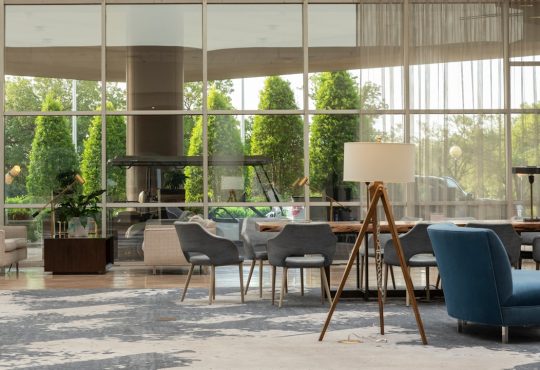
Urban Oasis: Innovative Urban Gardening Ideas for Small Spaces
Urban gardening has become increasingly popular in recent years as more people are recognizing the benefits of growing their own food and connecting with nature in urban environments. With limited space and resources, urban gardening offers a solution for those who want to cultivate plants and vegetables in small spaces. This article will explore various techniques and strategies for maximizing small spaces, including container gardening, vertical gardening, creative planters, hydroponics, miniature gardens, edible landscaping, green roofs, and community gardens.
Key Takeaways
- Urban gardening is becoming increasingly popular as people seek to connect with nature and grow their own food.
- Maximizing small spaces is key to successful urban gardening, and container gardening is a great solution for limited space.
- Vertical gardening allows you to grow plants up instead of out, making the most of your vertical space.
- Repurposing household items as creative planters is a fun and eco-friendly way to add some greenery to your urban space.
- Hydroponics is a soil-free method of growing plants that can be done indoors or outdoors, making it a great option for urban gardeners.
Maximizing Small Spaces: Tips and Tricks for Urban Gardening
In urban environments where space is limited, it is crucial to optimize the available area for gardening. One way to maximize small spaces is by utilizing vertical space. Hanging planters or trellises can be used to grow plants vertically, allowing for more plants to be grown in a smaller area. Additionally, utilizing windowsills or balcony railings can provide additional space for growing herbs or small plants.
Another tip for maximizing small spaces is to use compact or dwarf varieties of plants. These plants are specifically bred to grow in smaller spaces and require less room to thrive. Additionally, using raised beds or containers can help make the most of limited space by allowing for more efficient use of soil and water.
Container Gardening: The Ultimate Solution for Limited Space
Container gardening is a popular technique for urban gardening as it allows individuals to grow plants in small spaces such as balconies, patios, or even windowsills. Container gardening involves growing plants in pots or containers instead of directly in the ground.
One of the main benefits of container gardening is its versatility. Containers can be moved around easily, allowing for flexibility in terms of sunlight exposure and temperature control. This is especially beneficial in urban environments where sunlight may be limited due to tall buildings or shade from surrounding structures.
A wide variety of plants can be grown in containers, including vegetables, herbs, flowers, and even small fruit trees. However, it is important to choose plants that are suitable for container gardening. Plants that have shallow root systems or do not require a large amount of space to grow are ideal for container gardening.
Vertical Gardening: Growing Up Instead of Out
| Benefits of Vertical Gardening | Challenges of Vertical Gardening |
|---|---|
| Maximizes small spaces | Requires proper support structures |
| Reduces soil erosion | May require more frequent watering |
| Increases accessibility for people with disabilities | May limit plant selection due to space constraints |
| Improves air quality | May require more frequent fertilization |
| Provides fresh produce in urban areas | May be more expensive to set up initially |
Vertical gardening is another technique that is gaining popularity in urban environments. It involves growing plants vertically on walls, trellises, or other structures, allowing for more efficient use of space.
One of the main benefits of vertical gardening is its ability to maximize small spaces. By growing plants vertically, individuals can grow more plants in a smaller area. This is especially beneficial in urban environments where space is limited.
There are various types of plants that are suitable for vertical gardening, including climbing plants such as tomatoes, cucumbers, and beans. These plants can be trained to grow up trellises or walls, saving valuable ground space.
Creative Planters: Repurposing Household Items for Gardening
In addition to traditional pots and containers, there are many household items that can be repurposed for gardening. This not only adds a unique touch to the garden but also helps reduce waste by giving new life to old items.
Some examples of household items that can be repurposed for gardening include old buckets, tin cans, mason jars, and even old furniture such as dressers or drawers. These items can be transformed into unique planters by adding drainage holes and filling them with soil.
Using creative planters not only adds visual interest to the garden but also allows for more efficient use of space. For example, hanging planters can be used to grow trailing plants such as strawberries or ivy, while vertical planters can be used to grow herbs or small vegetables.
Hydroponics: Growing Plants Without Soil

Hydroponics is a method of growing plants without soil. Instead, plants are grown in a nutrient-rich water solution, allowing for more efficient use of resources and space.
One of the main benefits of hydroponics is its ability to grow plants in small spaces. Since plants are not grown in soil, they do not require as much space to spread their roots. This makes hydroponics an ideal technique for urban gardening where space is limited.
There are various types of plants that are suitable for hydroponics, including leafy greens, herbs, and even some fruiting plants such as tomatoes or peppers. These plants can be grown in nutrient-rich water solutions, providing them with all the necessary nutrients they need to thrive.
Miniature Gardens: Creating Tiny Landscapes in Small Spaces
Miniature gardens, also known as fairy gardens or terrariums, are a popular trend in urban gardening. These tiny landscapes allow individuals to create their own miniature worlds using small plants and decorative elements.
One of the main benefits of miniature gardens is their ability to bring nature into small spaces. Even in the smallest of apartments, individuals can create their own little oasis by incorporating miniature plants and accessories.
Creating a miniature garden is relatively simple. All that is needed is a container, some soil, and small plants or succulents. Decorative elements such as miniature furniture, figurines, or rocks can be added to create a whimsical and enchanting scene.
Edible Landscaping: Combining Beauty and Functionality in Urban Gardens
Edible landscaping is a technique that combines the beauty of ornamental plants with the functionality of growing food. It involves incorporating edible plants into the landscape design, creating a visually appealing and productive garden.
One of the main benefits of edible landscaping is its ability to provide fresh food in urban environments. By growing edible plants such as vegetables, herbs, or fruit trees, individuals can have access to fresh produce right at their doorstep.
There are various types of edible plants that are suitable for urban gardens, including leafy greens, tomatoes, peppers, herbs, and even small fruit trees. These plants can be incorporated into the landscape design, adding both beauty and functionality to the garden.
Green Roofs: Transforming Rooftops into Lush Gardens
Green roofs are becoming increasingly popular in urban environments as a way to transform rooftops into lush gardens. This technique involves covering the roof with vegetation, providing numerous benefits for both the building and the environment.
One of the main benefits of green roofs is their ability to reduce energy consumption. The vegetation on the roof acts as insulation, reducing the need for heating or cooling. This can result in significant energy savings for the building.
In addition to energy savings, green roofs also help reduce stormwater runoff and improve air quality. The vegetation on the roof absorbs rainwater, reducing the strain on stormwater systems. It also helps filter pollutants from the air, improving air quality in urban areas.
There are various types of plants that are suitable for green roofs, including sedums, grasses, and even small shrubs or trees. These plants are typically low-maintenance and can withstand harsh conditions such as wind or drought.
Community Gardens: Bringing Urban Gardeners Together for a Common Cause
Community gardens are a great way to bring urban gardeners together for a common cause. These gardens are typically shared spaces where individuals can come together to grow food, share knowledge, and build community.
One of the main benefits of community gardens is their ability to provide access to fresh food in urban areas. Many urban neighborhoods lack access to fresh produce, making community gardens an important resource for these communities.
In addition to providing fresh food, community gardens also offer numerous social and environmental benefits. They provide a space for individuals to connect with nature, learn new skills, and build relationships with their neighbors.
Starting a community garden can be a rewarding experience, but it does require careful planning and organization. It is important to secure a suitable location, gather support from the community, and establish guidelines for garden maintenance and use.
There are many successful examples of community gardens around the world, including the Brooklyn Grange in New York City and the South Central Farm in Los Angeles. These gardens have not only provided fresh food for their communities but have also become important gathering places for residents.
Conclusion: Recap of the benefits of urban gardening and encouragement for readers to start their own urban garden.
In conclusion, urban gardening offers numerous benefits for individuals living in urban environments. From maximizing small spaces to repurposing household items, there are various techniques and strategies that can be used to create a thriving garden in even the smallest of spaces.
Whether it’s container gardening, vertical gardening, hydroponics, or community gardens, there are endless possibilities for growing plants and vegetables in urban areas. Not only does urban gardening provide access to fresh food, but it also allows individuals to connect with nature, improve air quality, reduce energy consumption, and build community.
So why not start your own urban garden today? With a little creativity and some basic gardening knowledge, you can transform your small space into a lush oasis and reap the many benefits of urban gardening.
If you’re looking for more ways to create a sustainable and eco-friendly home, you might be interested in the article “Isolatie: Een Essentiële Stap voor Energiebesparing in uw Woning” (Insulation: An Essential Step for Energy Saving in Your Home). This article explores the benefits of proper insulation in reducing energy consumption and creating a more comfortable living environment. By insulating your home, you can not only save on energy costs but also contribute to a greener future. Check out the article here https://agutonsky.com/isolatie-een-essentiele-stap-voor-energiebesparing-in-uw-woning/ to learn more about the importance of insulation in energy efficiency.



